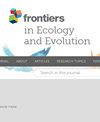加拿大北方森林纬度梯度巢网的持续性、变化和稳健性
IF 2.4
3区 环境科学与生态学
Q2 ECOLOGY
引用次数: 0
摘要
引言在加拿大东部,北方森林与森林组成和结构的重要纬度变化有关,这种变化发生在南方北方混交林和北方北方针叶林之间的过渡时期。在这一过渡时期,生长着大型落叶树(对依赖穴居的脊椎动物非常重要)的高地混交林逐渐被生长着小型针叶树(主要是黑云杉)的森林所取代。与此同时,被美洲河狸(Castor canadensis)淹没的低地森林也在减少,而这种森林可以为树洞使用者提供充足的条件。方法我们假设,这种纬度梯度会给脊椎动物蛀洞群落的功能多样性和网络结构带来重要变化。沿着这一纬度梯度,我们使用巢网方法分析了高地森林和被海狸淹没的低地森林中蛀洞使用者网络的结构和稳健性。结果我们发现,尽管北方森林地区的混交林较少,但在整个北方森林中,混交林一直是高地森林巢网网络结构的主要驱动力,而古老的黑云杉林的贡献较低。在低地森林中,海狸池塘中的巢网在两个森林地区都具有丰富而复杂的结构。物种移除模拟显示,在我们的纬度梯度上,高地和低地森林巢网的反应不同。在高地森林中,移除颤杨和啄木鸟(Dryocopus pileatus)造成的次生灭绝比例最高,这表明巢网的稳健性较低,因为这两个物种与其他物种的联系非常紧密。相比之下,海狸池塘中的巢网更为坚固,这主要是因为挖掘者物种使用了更多树种,尽管北椋鸟(Colaptes auratus)的移除造成了大量的二次灭绝。讨论我们讨论了在纬度梯度上,混交林和海狸池塘是使用蛀洞的脊椎动物群落的关键栖息地类型,在工业化木材采伐的景观中应如何维持和保护它们。本文章由计算机程序翻译,如有差异,请以英文原文为准。
Frontiers | Persistence, changes and robustness of nest webs along a latitudinal gradient in the Canadian boreal forest
IntroductionIn eastern Canada, the boreal forest is associated with an important latitudinal shift in forest composition and structure, which occurs in the transition between the mixed southern boreal forest and the coniferous northern boreal forest. Along this transition, upland mixedwood stands with large deciduous trees (important for cavity-dependent vertebrate species) are gradually replaced by forests with smaller conifer trees, primarily black spruce (Picea mariana). Concomitantly, the availability of lowland forests flooded by the American beaver (Castor canadensis), which can provide adequate conditions for tree-cavity users, is also decreasing.MethodsWe hypothesized that this latitudinal gradient would bring important changes in the functional diversity and network structure of vertebrate cavity-using communities. Along this latitudinal gradient we used a nest web approach to analyze the structure and robustness of networks of cavity users in upland forests and in lowland forests flooded by beavers.ResultsDespite their low availability in the northern forest region, we found that mixedwood stands persisted throughout the boreal forest in being the main drivers of nest webs network structure of upland forests whereas old black spruce stands contribution was low. In lowland forests, beaver ponds harbored nest webs with a rich and complex structure in both forest regions. Species removal simulations revealed that across our latitudinal gradient upland and lowland forest nest webs responded differently. In upland forests, the removal of trembling aspen and the Pileated Woodpecker (Dryocopus pileatus) caused the highest proportions of secondary extinctions, showing low robustness of nest webs given that these two species were highly connected to the other species. Contrastingly, nest webs in beaver ponds were more robust mainly because excavator species used a higher diversity of tree species despite the removal of the Northern Flicker (Colaptes auratus) which induced numerous secondary extinctions. The Pileated Woodpecker remained the pivotal species across the two forest regions in upland forests whereas the Northern Flicker became the main large cavity provider in beaver ponds across the latitudinal gradient.DiscussionWe discuss how mixedwood forests and beaver ponds, which are key habitat types for the cavity-using vertebrate community across our latitudinal gradient, should be maintained and protected in landscapes under industrial timber harvesting.
求助全文
通过发布文献求助,成功后即可免费获取论文全文。
去求助
来源期刊

Frontiers in Ecology and Evolution
Environmental Science-Ecology
CiteScore
4.00
自引率
6.70%
发文量
1143
审稿时长
12 weeks
期刊介绍:
Frontiers in Ecology and Evolution publishes rigorously peer-reviewed research across fundamental and applied sciences, to provide ecological and evolutionary insights into our natural and anthropogenic world, and how it should best be managed. Field Chief Editor Mark A. Elgar at the University of Melbourne is supported by an outstanding Editorial Board of international researchers. This multidisciplinary open-access journal is at the forefront of disseminating and communicating scientific knowledge and impactful discoveries to researchers, academics and the public worldwide.
Eminent biologist and theist Theodosius Dobzhansky’s astute observation that “Nothing in biology makes sense except in the light of evolution” has arguably even broader relevance now than when it was first penned in The American Biology Teacher in 1973. One could similarly argue that not much in evolution makes sense without recourse to ecological concepts: understanding diversity — from microbial adaptations to species assemblages — requires insights from both ecological and evolutionary disciplines. Nowadays, technological developments from other fields allow us to address unprecedented ecological and evolutionary questions of astonishing detail, impressive breadth and compelling inference.
The specialty sections of Frontiers in Ecology and Evolution will publish, under a single platform, contemporary, rigorous research, reviews, opinions, and commentaries that cover the spectrum of ecological and evolutionary inquiry, both fundamental and applied. Articles are peer-reviewed according to the Frontiers review guidelines, which evaluate manuscripts on objective editorial criteria. Through this unique, Frontiers platform for open-access publishing and research networking, Frontiers in Ecology and Evolution aims to provide colleagues and the broader community with ecological and evolutionary insights into our natural and anthropogenic world, and how it might best be managed.
 求助内容:
求助内容: 应助结果提醒方式:
应助结果提醒方式:


